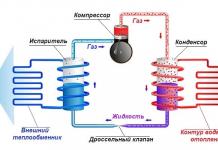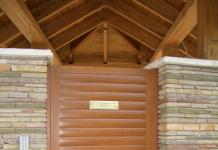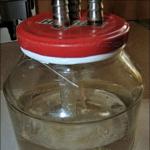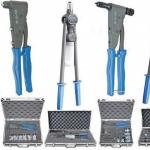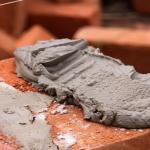The strength of brickwork depends not only on the properties of the brick, but also on the quality of the masonry mortar. The composition of the mortar for laying bricks should be different for different purposes - for laying the walls of the house and the stove, the mixture will be completely different. What are masonry mortars made of and what are the proportions of the components?
Properties of the masonry mix
The mortar for laying bricks must have the following properties:
- strength under mechanical and atmospheric action, with insufficient strength, the walls can be deformed, but excess is also harmful - the mixture turns out to be non-plastic;
- good adhesion with brick; insulating properties (water resistance, the ability to retain heat and sounds);
- mechanical properties that make it possible to apply a sufficiently thin layer;
- the setting time is about 1-1-.5 hours, so that it is convenient to work with it without haste.
These qualities depend on the composition of the mixture and the proportions of its components. Another important property is mobility. It is measured in centimeters and is defined as follows: they measure how much a cone 15 cm high, an angle of 30 degrees and a mass of 0.3 kg will plunge into the mass. If a solid brick is laid, then the mobility should be within 9-13 cm, for walls made of brick with voids - 7-8 cm. If the work is carried out in extreme heat, then the mobility should be equal to 12-14 cm.

The mortar must be of such a consistency that it does not drain from the brick. The readiness of the mixture is easy to check: for this, the bucket is tilted at an angle of 40 degrees. If the mixture does not pour out, it is of optimal consistency and ready to go.
By strength, several grades of solutions are distinguished:
- 0, 2 are rarely used,
- 4, 10, 25, 50, 75 are the most commonly used,
- 100, 150, 200 - used for special construction.
Strength shows how many kilograms can withstand 1 sq. cm of the solution area. This property is determined by special installations.
Components
The main components of the brick laying mixture are: lime, cement, clay or gypsum, sand, water, additives. What role does each of them play? Cement, lime, clay and gypsum act as binders. They are responsible for curing. Compositions that include one binder component are called simple, two or more - complex.

Most often, for brick walls and houses, a cement-based masonry mixture is used. It is best to take cement grade M 400, in general, the higher the grade of cement, the lower its consumption. Cement has sufficient rigidity and strength. There is also lime, cement-lime and cement-clay mortar. Many people think that cement mortar for any type of masonry is better than others, but this is not so. In some cases, it will be too rigid and overly strong. Mixtures for laying bricks of a different composition have their own application features.
Important! Portland slag cement is not used for construction in cold weather. A solution based on it at low temperatures is of poor quality.
For walls that carry a small load, such as fences, interior partitions, lime mortar is used. It shrinks slightly, has low thermal conductivity, that is, it retains heat well, but after solidification it becomes brittle. This limits its scope. It is also used to repair walls.

To prepare such a mixture, quicklime powder is used. The composition is made warm, it turns out to be more plastic than cement, it does not harden longer. The composition using lime and cement is used for various structures, its advantage is a better heat-insulating ability than that of cement.
The cement-clay composition is the least durable of those listed. It is used for working with stone, brick, ceramics, for example, for laying stoves. It has high frost resistance, is durable and cheap. For its preparation, it is important that the clay be free of impurities and foreign inclusions (stones, roots).
Compositions with a large proportion of the astringent component are called fatty, with a smaller proportion - normal or lean. The ratio of ingredients in normal mixtures is optimal in terms of price and quality.
Sand plays the role of a filler, it increases the volume and improves the mechanical properties of the mixture. Sometimes other ingredients are used for this, such as gravel, expanded clay, polystyrene granules. Usually they are used not for masonry, but for pouring solutions. The sand should be fine, without impurities (garbage, clay, earth, roots), it is best to use river sand. Bright yellow sand should not be used in face masonry or for bricks with cavities.

Water is the most important component of masonry mortar. Many characteristics of the composition depend on its quality, therefore the requirements for water are prescribed in GOST 23732-2011. To prepare the solution, the water must be clean, with a temperature in the range of 15-20 degrees.
Additives can be:
- plasticizers - make the composition more plastic, and it is easier to work with it, they are necessarily added to the mixture for laying facade bricks;
- hardeners - accelerate the hardening (polymerization) of the mixture;
- anti-frost additives - do not allow the mass to freeze at sub-zero temperatures, giving it the opportunity to freeze well;
- pigments - color the solution in the desired color, if you need to get a mixture of dark color, you can use soot or graphite.
Options with various additives are more economical and easier to work with, so it’s better to spend time and prepare a brick mortar with improving additives, and then make the masonry faster and better.

Proportions
The preparation of a mortar for laying bricks begins with mixing all the dry ingredients, and then adding water to the desired consistency.
For many works, a simple cement mortar of the M75 brand is used in a ratio of 1: 3 - 1 part of cement to 3 parts of sand. The proportions of the batch for brick construction depend on the brand of cement. For cement-sand mixture:
- M 400 - the ratio of cement and sand is 1: 2.5;
- M 500 - cement and sand are taken in a ratio of 1: 3.
For a complex cement-lime composition:
- M 300 - cement, sand and lime are taken in a ratio of 1: 3.5: 0.2;
- M 400 - 1 part of cement, 1-0.3 parts of lime, 2.5-4 - sand;
- M 500 - the ratio of the amount of cement, sand and lime should be equal to 1: 3: 0.2.
Water for cement-sand mixtures take 0.8 parts for every 1 part of cement. Cement of various grades per cubic meter of brickwork is consumed:
- M100 - 300-250 kg;
- M150 - 400-330 kg;
- M200 - 490-410 kg;
- M300 - 600-510 kg.

How to prepare lime mortar? It is prepared from 1 share of quicklime and 2-5 shares of sand. Water is poured in until the mass is the consistency of sour cream. It should not have lumps.
Cement-lime mortar is prepared by mixing cement, lime and sand in a ratio of 1:1:6 to 1:3:15. In this case, the moisture content of sand and lime should be taken into account. First, lime is diluted with water to the state of milk of lime and filtered through a sieve, and then a dry mixture of sand and cement is diluted with this milk of lime.
How to make a clay-based solution? It includes 1 part clay and 1-2 parts sand. It can be used, for example, for laying a stove in a bath.

How much mixture is needed for laying 1 sq.m of brick? Usually, about 0.25 cubic meters of mortar is spent, but if the brick has cavities, the consumption increases.
Universal option
The cement-sand mortar according to the recipe below can be used in many construction works.
To make a solution, you first need to prepare all the ingredients: cement, sand, water, detergent, which plays the role of a plasticizer. Detergents such as dishwashing liquid or liquid soap are a cheap substitute for specialty additives. They increase plasticity, add them in the amount of 1 teaspoon per bucket of cement. The brand of cement should be M 400 or M 500, sand with a fraction of 2 mm.
The proportions depend on the purpose of the composition. A solution of the M25 brand with a 5: 1 ratio of sand and cement is used for most work, but for critical places where special strength is required, for example, for foundations, plinths, the M50 grades (with a ratio of 4 to 1) and M75 (3 to 1) are used .

The M25 brand solution is prepared as follows. 1 cubic meter is obtained from:
- 2064 kg of sand;
- 268 kg of cement;
- 340-350 liters of water.
Usually, the dry ingredients are first mixed, and then they are diluted with water, but you can do it differently. First, water is poured into the concrete mixer, and then the dry ingredients are gradually added. This sequence will allow you to better control the density of the mixture.
In the water poured into the concrete mixer, first pour the detergent. After stirring for a few minutes, it will give foam. Next, the sand is poured.
Attention! First, only half of the sand is covered.
After the sand, cement is added and mixed until smooth. Then add the remaining half of the sand and mix thoroughly again. As a result, the consistency of the mass should be like thick sour cream. Checking the density of the mixture is simple: if you run your finger over it, a clear mark should remain that does not blur.
After mixing all the ingredients, they are stirred for 2 minutes. After that, the mixture is ready to go. So that the cement does not delaminate, it also needs to be mixed occasionally during operation.
Do not prepare a lot of working mixture at once. Remember that in one and a half to two hours it begins to harden and becomes unusable due to loss of plasticity.

Conclusion
The ratio of the components included in the mortar for masonry depends both on their quality (grade of cement, moisture content of sand and lime), and on the purpose of the mixture. To work with different bricks, laying walls with a large or small load, different solutions are needed. It is important to observe these ratios exactly so that the structure is strong and reliable.
Brickwork is the basis of many buildings. With the help of bricks, structures of various purposes and strength are erected. Proper preparation of mortar for laying bricks largely determines the quality and reliability of the entire construction.
In order to build a high-quality and reliable brick structure, it is necessary to properly prepare the mortar.
By changing the composition of the solutions, it is possible to influence the parameters of brick walls. Various additives can change the capabilities of such a binder. The preparation of a mixture for laying bricks is a fairly simple, but very responsible matter. Compliance with manufacturing technology and composition is the key to the strength of the house.
Features of mortar for bricklaying
In general, a bricklaying mortar is an aqueous mixture of a binder with a filler, in which additives can be added to impart additional properties. It should be remembered that the mortar for masonry differs markedly from mixtures intended for other purposes (for example, plaster).

Cement and lime are used as a binder (base), either individually or in combination. The main filler is sand. Clay can be used in combination with it. In addition, plasticizers and other additives can be added to the composition of the mixture to increase heat resistance, resistance to moisture, steam, etc. It is quite common to use detergents to increase elasticity.
There are a number of requirements for mortars for laying brick walls. They must have good adhesion to the brick, which ensures reliable adhesion to it. It must be elastic enough to spread evenly and effortlessly over the surface and fill the irregularities in the brick. It is important that the mixture after hardening has a high compressive strength. The setting time of the solution should allow it to be used. In addition, additional conditions include thermal resistance, resistance to moisture.
An analysis of the use of different binders shows the following. Lime mortar has high elasticity and good thermal insulation properties, but has low mechanical strength. It can only be used in minor buildings - fence, light outbuildings. Cement mortar has increased mechanical strength, excellent adhesion to brick, but is considered a cold and insufficiently plastic material. Many disadvantages are eliminated by using a cement-lime mortar, which is sufficiently strong and elastic. It also finds wide application in the preparation of mortars for laying bricks.
Back to index
Basic properties

Solutions have their own brands, which can be assigned even to those options that are prepared by hand. It is customary to fix the brand in the following form: for example, M50 is a solution having a compressive strength of 50 kg / cm³. The M10, M25, M50 and M75 options are most used for bricklaying. Solutions M100 and above are used in especially durable structures. The strength test can be carried out independently - a cube of mortar with a side of 7 cm after 28 days of drying is subjected to a compressive load.
An important normalized parameter is mobility. To determine the mobility, a cone with an angle of 30º at a height of 15 cm, having a mass of 300 g, is immersed in a fresh solution. It is customary to consider mobility by the depth of immersion of the cone (in cm) for 1 hour. For laying red bricks, mobility should be no more than 13, and for hollow bricks - no more than 8. When building in warm weather, mixtures with high mobility are recommended.
Back to index
Requirements for the components of the mixture
When preparing a solution, special attention is paid to the quality of the components. Water for the solution should not contain impurities, oils, dirt. The best results are shown by well and spring water. If the mixture is prepared in the summer, then the water should be cold, i.e. not heated by direct sunlight; and in winter, on the contrary, it needs to be heated a little. Sand is used well cleaned and sifted. It should not contain clay and impurities. Cement determines the main properties, so it should be checked very carefully. When buying, you should make sure that the packaging is not broken. Cement that has been stored in a humid atmosphere is unusable. Lime should be used in slaked form. Almost any detergent can be used - shampoo, washing powder, etc. Do not use only cleaning agents.
Back to index
Making a simple solution with your own hands

The simplest mortar for laying bricks is an aqueous mixture of two components (cement or lime with sand). In the construction of houses, a simple cement-sand mortar is used. It is prepared in proportion: for one part of cement, 3 parts of sand. Such a mixture in dry form is loaded into a container of the pallet type (with an increased area) and thoroughly mixed. When the mixture acquires a uniform gray color, water is gradually added to it with constant stirring. The mixture should acquire a viscous consistency that allows its application to the surface; without being too liquid. The last condition is easy to check by tilting the container by 40º - nothing should spill out.
If the question arose, how to prepare a mortar for laying bricks of different strengths, i.e. different brands, then the ratio of the components should be changed. It has been determined in a practical way that the M50 solution is obtained by diluting a mixture of cement (Portland 300 brand) and sand in a ratio of 1:5; M75 - at a ratio of 1: 3; M100 - 1: 2; M150 - 1: 1.5.
Back to index
Cement-sand mortar with lime
When it is necessary to decide how to prepare a solution with increased elasticity, it is worth adding slaked lime. Such a solution will retain its plasticity for up to 5 hours. It is undesirable to use this solution in the basement of the outer wall with high soil moisture. A mixture is recommended in the following ratio of cement, lime and sand: 1:1:4 (based on the use of Portland 400 cement), which corresponds to the M75 grade. For the M50 brand, this proportion will be 1: 0.5: 4.5.
The preparation of the solution is as follows. First, lime dough is prepared - a mixture of lime and sand is diluted in water with stirring until the consistency of thick sour cream. Then the cement is mixed with lime paste with the addition of water with constant stirring.
In the production of construction works, various solutions are used everywhere and everywhere: for laying stone walls and structures, for plastering,.
The composition of the solution usually includes only a few components, so its preparation seems to many to be a simple matter and does not require preparation. But that's not the case at all. For each type of work, a suitable solution is needed, with carefully adjusted proportions of the components. It is also necessary to knead the solution correctly, otherwise its quality may suffer greatly.

Particular attention must be paid to the preparation of masonry mortars, since the strength and reliability of wall and other load-bearing structures that are critical for the normal operation of the building depend on them.
Mortars used for laying various structures can be classified according to various criteria.
 The solution is prepared from several components:
The solution is prepared from several components:
- binder;
- filler;
- water for mixing.
The binder of the masonry mortar can be such materials as:
- lime;
- clay;
- cement.
Moreover, only one type of binder is not necessarily used to prepare the solution, there may be two. The compressive strength of the solution depends on the type of binder material.
Therefore, it will be the first sign of classification:

- Solution group I - lime serves as a binder for these solutions. There are no requirements for compressive strength for such mortars; therefore, they can be used for laying buildings with a height of no more than two floors. In this case, the thickness of the wall cannot be less than 24 cm.
- Solution groups II and IIa. The binders here are lime and cement. These mortars can be used for laying internal and external normally loaded walls, since the mortars of these groups have normal compressive strength.
- Solution groups III and IIIa. The binder of these solutions is exclusively cement. The ratio of components in both groups is the same, but for group IIIa, an aggregate that meets the highest requirements is used. The strength of these solutions is high, so they can be used for laying especially loaded supports, pylons and walls.
Also, according to the type of binder, the solutions are divided into:
- calcareous;
- cement-lime;
- cement-sand;
- cement-clay;
- clay.
Adding lime or clay to the solution makes it more plastic.
 The classification of solutions by brand is also widely used:
The classification of solutions by brand is also widely used:
- grades 0 and 2 are weak solutions, therefore they are rarely used;
- grades 4, 10, 25.50, 75 are the most popular;
- grades 100, 150 and 200 - used in the production of specific works and laying of especially critical structures.
Sometimes the mobility of the solution is of great importance. It is determined by immersing a special standard cone in a fresh solution.
The lower the cone plunges, the higher the mobility of the solution:

- a solution with a mobility of 7 - 8 is used for laying a hollow;
- 9 - 10 - for full-bodied;
- 12 - 14 - if necessary, work in hot weather.
Depending on the volume of sand, the mixtures are divided as follows:
- fatty - solutions with an excess of binder, their use can lead to cracking of the masonry;
- normal - cooked exactly according to the recipe;
- skinny - they have too much sand, so they are loose and cannot give the masonry sufficient strength.

The saturation of the mixture can be determined by eye: if the solution freely “moves out” from the shovel, then the mixture is lean; if it sticks to it in small pieces - normal; if it completely envelops the surface of the shovel - bold.
Proportions of masonry mortar
In order to choose the correct ratio of the components of the masonry mixture, you need to know what brand of mortar is needed for masonry of a particular design.
The most popular brands are M25, M50 and M75. The ratio of the components of the solution depends on the brand of cement used for its preparation. Typically, cement grades 300, 400 and 500 are used to prepare the masonry mixture.
For cement-sand mortars, the ratio of components is approximately as follows:
| Grade of cement | Solution grade | The ratio of cement and sand |
| 300 | 25 | 1:9,5 |
| 50 | 1:5,8 | |
| 75 | 1:4,2 | |
| 100 | 1:3,4 | |
| 150 | 1:2,6 | |
| 400 | 50 | 1:7,4 |
| 75 | 1:5,4 | |
| 100 | 1:4,3 | |
| 150 | 1:3,25 | |
| 500 | 75 | 1:6,7 |
| 100 | 1:5,3 | |
| 150 | 1:3,9 |
To put it simply, the grade of the mixture is approximately equal to the quotient of dividing the grade of cement by the number of volume parts of sand.
 For the preparation of solutions, only bulk parts of the components are always used. You can't rely on weight. The volume of water in the masonry mixture can vary between 0.6 - 0.8 of the volume of cement. Most often it is determined by eye, based on the quality of the solution.
For the preparation of solutions, only bulk parts of the components are always used. You can't rely on weight. The volume of water in the masonry mixture can vary between 0.6 - 0.8 of the volume of cement. Most often it is determined by eye, based on the quality of the solution.
If you need to lay out a solid structure, then use a cement-sand mortar. But you need to remember that it seizes quickly, so the time of its use does not exceed 2 - 2.5 hours. Therefore, it is necessary to carefully calculate the amount of the prepared mixture in order to have time to work it out over this period of time.
If it is necessary to extend the life of the masonry mixture, lime is added to it. This doubles the shelf life of the solution.
To obtain high-quality masonry, it is important to carefully prepare the components of the solution:

- Cement is best purchased immediately before starting. Do not use "old stocks", such material has already lost its strength.
- Sand is better to buy river. It must be clean and free of debris. Good river sand has a gray color, yellowness is given to it by particles of clay, which in this case are completely undesirable. For masonry, sand of medium fraction is used - at least 2 mm.
- should be cold and clean (ideally - 15 - 20 degrees). The presence of acid and oil impurities in it is unacceptable.
In order to properly prepare the solution, you will need:
- large capacity - it can be a mortar mixer or a bucket (if the mixture is supposed to be mixed manually);
- buckets with a volume of 10 - 12 l;
- shovel.
If the amount of work is small, then you can measure the components with a shovel, but if there is a lot of work to be done and a lot of mortar is needed, then it is better to use buckets.
- First, sand and cement are poured alternately into the container in measured quantities.
- Then the dry mass is thoroughly mixed and sifted through a sieve.
- Next, you need to gradually add water and constantly mix the mixture. At the same time, care must be taken not to add too much water - this negatively affects the quality of the masonry mortar.
It is often possible to come across a recommendation to moisten all containers with water before starting the preparation of the solution - this reduces the amount of waste during mixing. The mixture is mixed for 3-5 minutes, and then you need to let it stand for a while to get the right consistency.
During masonry work, the mixture must be constantly stirred, as it tends to separate.
If you need to get a plastic solution, you will have to add lime to the mixture.
 It can be used in two ways:
It can be used in two ways:
- in the form of dry ground slaked lime;
- in the form of prepared lime milk.
Lime milk is obtained as follows: slaked lime is diluted with water to the consistency of thick milk and filtered through a sieve. Then the solution is closed with this silence.
Observing the technology and the ratio of components, it is easy to obtain a high-quality masonry mixture.
The preparation of mortar for brickwork has never been considered a difficult construction operation, and in the brigades this work is performed by the youngest and most inexperienced. But mistakes in its execution are immediately evident to professionals, and their elimination does not require much time and effort.
Properly prepared mix for laying bricks must meet certain requirements. There are only three of them, but failure to comply with even one of them makes high-quality masonry impossible. First, the mixture must be sufficiently plastic. This is important, since the quality of filling irregularities and voids in brickwork depends on its plasticity.
Secondly, the setting time must be optimal. If the prepared mixture hardens too quickly, then it will be impossible to use it for masonry. Cement-based mixtures retain their plasticity for 1.5-2 hours, and when lime is added to them, this period increases to 5 hours. Thirdly, maintaining sufficient strength after complete solidification. If the hardened mixture is not strong enough, then the laid masonry is likely to deform.
Back to index
The main components of the solution

To fix bricks in masonry, various types of mortars are used. But they are all prepared according to a similar technology. The composition of any mortar for laying bricks necessarily includes a binder, a filler (usually sand is used for these purposes) and water. They differ only in the astringent component. If necessary, for better plasticity and viscosity, clay, PVA glue or other additives are sometimes added to the mixture being prepared.
As a binder for the preparation of the solution can be used:
- lime;
- cement;
- cement-lime mixture.
Mortar for laying bricks using lime is almost never used. Lime makes it warmer, but it is also the main reason for the lack of strength of the mixture. The only places where bricks can be laid on lime mortar are the foundations of furnaces and brick chimney stacks. Depending on the fat content of lime, the proportions of mortar for laying bricks can vary from 1:2 to 1:5 (1 part lime to 2-5 parts sand).

Cement-based bricklaying mortar has been and remains the most popular among amateur masons. Although it is the coldest and toughest of the three types, it is also the most durable of them all. The plasticity of the cement mixture depends on the amount of cement in it. The proportions of cement and sand, depending on the brand of cement and the requirements for masonry walls, can vary in a wide range: from 1:2 to 1:5.
Unlike amateurs, professionals prefer cement-lime mixtures. Due to the presence of lime milk in the composition, they are warmer and more plastic than purely cement ones, but remain strong enough, which makes it possible to use them for almost any type of brickwork.
Their only drawback is that they cannot be used in conditions of high humidity. The optimal ratio of cement, lime and sand for mortar brand M25 is 1:1:4; for a solution of brand M50 - 1: 0.5: 4.5.
Back to index
Technology of high-quality solution preparation

The main secret of a well-prepared solution is in the right proportion of mixing its components. To prepare a mortar for masonry, you will need the usual tools:
- large capacity for mixing components;
- buckets (can be old, but always clean);
- shovel;
- Master OK.
If large volumes of brickwork are expected and a team of builders will be involved, then it is advisable to use a concrete mixer as a container for preparing the mortar, it will save you from heavy monotonous work - mixing by hand.
But if the amount of work is small and you intend to do it yourself, then it is better to prepare the mixture by hand. The setting time of the vast majority of cement mortars for masonry is 1.5-2 hours, having prepared even half the concrete mixer of the mortar, you still will not have time to use it in the allotted time, therefore, waste materials and time for preparation.
Before preparation, sand must be prepared for use, i.e. sift, cleaning it as much as possible from litter and impurities. It is best to use river sand, but regular, quarry sand is also suitable, the main thing is that it be of a fine fraction, no more than 2.5 mm.
Then, sand and cement are poured into the container for preparing the solution with buckets in the right proportion. If you do not know the exact proportion you need, then it is better to start with the most common one - 1: 4 (1 bucket of cement and 4 sand).
Filling up 4 10-liter buckets of sand and 1 of the same bucket of cement, you will end up with not 50 liters of the mixture, but only 40, since the cement will fill the space between the grains of sand, but will not increase them in volume. In the future, by increasing the proportion of sand or cement, you can always correct the prepared solution to the plasticity you need.
First, cement and sand are thoroughly mixed by hand until a homogeneous mass is obtained, after which the resulting mixture is mixed with water. The average rate of water use is approximately 0.8 liters per 1 kg of cement. But these figures are not accurate, the amount of water added to the cement-sand mixture is usually determined already during the preparation of the mixture, adding a little liquid until the prepared solution acquires the desired consistency.
To mix the mixture, clean water is needed, preferably at room temperature (15-20º). All the time, while you add water, the mixture must be thoroughly mixed. Do not miss this nuance, since sand, as the heaviest component of the mixture being prepared, will all the time settle to the bottom of the tank, squeezing up the water in the mixture. A properly prepared mixture should look like thick homemade sour cream in appearance.
Knowing all the nuances of preparing a masonry mortar, you can easily prepare it yourself without resorting to the help, and far from free, of construction companies. The main thing is not to deviate from the right technology and not give up after a possible failure.
The physical properties of the cement mixture allow it to play a dominant role in a variety of building and finishing works. However, depending on the degree of application, the ratio of components in such mixtures should be different. In this material, we will analyze the ratios for the preparation of the most popular solutions.
- M100-150 - concrete used for the construction of various non-critical structures that do not perform load-bearing functions. Most often it is used for filling footpaths and sidewalks, since they almost do not experience heavy loads;
- M200-250 - often used to cover roads, while not experiencing heavy loads. In addition, ceilings and reinforced concrete belts are made from this concrete;
- M300-350 - used in the construction of foundations, floor slabs, roads with heavy loads, landings, as well as pipes, wells and paving slabs;
- M400-450 is one of the most durable types of concrete. It is used in the construction of high-strength floor slabs, floors in workshops, garages and other facilities where these parts of the building have a large load. At the same time, with the help of this concrete, a foundation and load-bearing structures are created;
- M500 is the strongest of the currently used concrete grades. It is used in the most critical work, and, unlike other types of this material, does not lose its properties even in the most difficult operating conditions.
The ratio of sand and cement for brickwork
Depending on the brand of cement, its ratio with sand can be different - from 1 to 3 to 1 to 6. The most popular option is the classic mixture, consisting of one part of cement to three parts of sand. The latter is usually taken in the middle fraction. In this case, the dry components are first mixed to a homogeneous state, after which water is poured. In the process of mixing, we achieve such a consistency that the mixture does not flow out when the container is tilted by 40 degrees. In this case, the water should be cold (15 degrees) and always clean. Below we present the proportions depending on the brand of cement and other additives:
- Cement-sand mortar with cement grade 500 - 1 part of cement to 3 parts of sand;
- Cement-sand mortar with cement grade 400 - 1 part of cement per 2.5 parts of sand;
- Mortar using lime - 1 part of cement (500, 400, 300) for 3, 2.5-4 and 3.5 parts of sand, as well as 2/10, 1.3/10 and 2/10 parts of lime, respectively.
In this case, the amount of water is usually 8/10 parts per 1 part of the cement-sand mixture. In the case of a brand 100 solution, from ½ to 7/10 parts of water is taken for 1 part of the latter. The last solution is just used to create brick walls. In the case of a 115 mortar, a 350 grade cement is usually used with an appropriate amount of water and sand. Such a solution is ideal for laying bricks as part of the external cladding of a building.
Brand of cement for the foundation and its ratio with sand and gravel
The foundation is the most important part of any structure, and the stability, durability and safety of the house will depend on its strength. In this regard, when building a foundation, it is necessary to use correctly selected cement. The brand of the latter depends on the load that the foundation part will experience in the future. The brand of concrete means the compressive strength of the hardened composition. The higher the number, the higher the strength, however, the higher the price. But when building a foundation, it is contraindicated to save on quality.
In the case of concrete preparation, cement grade 100 can be used. However, for the construction of the foundation, we will use options from M300 and higher. If you want to achieve maximum structural strength, then take the M500, since its price is not much different from the M400. As for the ratio, it is usually 1-3-5 in terms of cement, sand and gravel.

The ratio of sand and cement for the preparation of concrete
When erecting reinforced concrete structures, we must accurately calculate the proportions of the components and the grade of cement. With regards to the latter, you can focus on the description given at the beginning of the article, choosing a brand depending on where exactly the mixture will be used.
As for the composition of concrete, here, in addition to cement, sand and water, crushed stone, gravel and other solid fractions are often used. At the same time, all this can be mixed in a variety of proportions, depending on the task and the master conducting the work. As practice shows, the most common is the following combination: 1 part of cement, 4 parts of crushed stone, 2 parts of sand and ½ part of water. But here it is necessary to take into account various additives that give concrete certain properties. If they are used, we will have to act according to the instructions.
The ratio for the installation of plaster and pouring screed
The amount of water in this case can be very different, depending on the task. In this case, the mixture usually consists of cement and sand, diluted in proportions of 1 to 5.
As for the floor screed, strength is an important factor here, which should have a minimum threshold of 10 MPa. In this case, it is best to select concrete grade M150, since this parameter in its case is 12.8 MPa. In general, the proportions of the mixture may depend on the following factors:
- The need to hide various communications;
- The degree of leveling and elevation of the surface.
It is worth immediately deciding that when screeding the floor in houses and apartments, it is best to use a solution of 100 or 150. In general, depending on the required brand of mortar and cement, the dilution parameters with sand can be as follows:
- Mortar 100, cement 200 - 1 part cement to 3 parts sand;
- Mortar 150, cement 300 - 1 part cement to 2 parts sand;
- Mortar 200, cement 300 - equal parts;
- Mortar 150, cement 400 - 1 part cement to 3 parts sand;
- Mortar 200, cement 400 - 1 part cement to 2 parts sand;
- Mortar 300, cement 300 - equal parts.
Important! Pay maximum attention to mixing the cement slurry for your needs. Incorrect proportions of components can call into question the strength of the structure to be poured. Especially when it comes to foundations, load-bearing structures or floor slabs.

